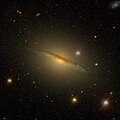| NGC 681 | |
|---|---|
 legacy surveys image of NGC 681 legacy surveys image of NGC 681 | |
| Observation data (J2000 epoch) | |
| Constellation | Cetus |
| Right ascension | 01 49 10.829 |
| Declination | −10° 25′ 35.13″ |
| Redshift | 0.00587 ± 0.00002 |
| Heliocentric radial velocity | 1760.4 ± 6.6 km/s |
| Distance | ~66.5 million ly (20.39 ± 1.45 Mpc) |
| Group or cluster | MCG -02-05-053 Group (LGG 33) |
| Apparent magnitude (V) | 12 |
| Characteristics | |
| Type | SAB(s)ab |
| Mass | 1.9×10 M☉ |
| Mass/Light ratio | 3.6 M☉/L☉ |
| Size | ~29.07 kpc (diameter) |
| Apparent size (V) | 2.70 × 1.8 arcmin |
| Other designations | |
| IRAS 01467-1040, MCG -02-05-052, PGC 6671 | |
NGC 681 is an intermediate spiral galaxy in the constellation of Cetus, located approximately 66.5 million light-years from Earth.
NGC 681 is a member of the MCG -02-05-053 group (also known as LGG 33), which contains four galaxies, including NGC 701 and IC 1738.
Observation history
NGC 681 was discovered by the German-born British astronomer William Herschel on 28 November 1785 and was later also observed by William's son, John Herschel. John Louis Emil Dreyer, compiler of the first New General Catalogue of Nebulae and Clusters of Stars, described NGC 681 as being a "pretty faint, considerably large, round, small (faint) star 90 arcsec to west" that becomes "gradually a little brighter middle".
Physical characteristics
NGC 681 shares many structural similarities with the Sombrero Galaxy, M104, although it is smaller, less luminous, and less massive. Its thin, dusty disc is seen almost perfectly edge-on and features a small, very bright nucleus in the center of a very pronounced bulge. Distinctly unlike M104, NGC 681's disc contains many H II regions, where star formation is likely to be occurring. The galaxy has a mass of 1.9×10 M☉, a mass-to-light ratio of 3.6 , and a spiral pattern which is asymmetrical.
The SIMBAD database lists NGC 681 as a Seyfert II Galaxy, i.e. it has a quasar-like nucleus with very high surface brightnesses whose spectra reveal strong, high-ionisation emission lines, but unlike quasars, the host galaxy is clearly detectable.
Supernova
One supernova has been observed in NGC 681. SN 2024abup (type Ib/c, mag. 17.018) was discovered by ATLAS on 22 November 2024.
Image gallery
-
 SDSS image of NGC 681
SDSS image of NGC 681
See also
References
- ^ "NGC 681 NASA/IPAC Extragalactic Database Results". ned.ipac.caltech.edu. Retrieved November 2, 2018.
- ^ "New General Catalog Objects: NGC 650 - 699". cseligman.com. Retrieved November 2, 2018.
- ^ Burbridge, E. M.; G.R., Burbridge; Prendergast, K.H. (1965). "Rotation and Mass of the SA Galaxy, NGC 681". Astrophysical Journal. 142: 154–159. Bibcode:1965ApJ...142..154B. doi:10.1086/148270. hdl:2060/19650010085.
- ^ "Revised NGC Data for NGC 681". spider.seds.org. Retrieved November 2, 2018.
- "NGC 681". SIMBAD. Centre de données astronomiques de Strasbourg. Retrieved 2021-02-19.
- Garcia, A. M. (1993). "General study of group membership. II. Determination of nearby groups". Astronomy and Astrophysics Supplement Series. 100: 47. Bibcode:1993A&AS..100...47G.
- ^ Faber, S. M.; Balick, B.; Gallagher, J. S.; Knapp, G. R. (1977). "The neutral hydrogen content, stellar rotation curve, and mass-to-light ratio of NGC 4594, the "Sombrero" galaxy". The Astrophysical Journal. 214: 383–389. Bibcode:1977ApJ...214..383F. doi:10.1086/155260. ISSN 0004-637X.
- "NGC 691". SIMBAD. Centre de données astronomiques de Strasbourg. Retrieved 23 November 2024.
- "SN 2024abup". Transient Name Server. IAU. Retrieved 26 November 2024.
External links
 Media related to NGC 681 at Wikimedia Commons
Media related to NGC 681 at Wikimedia Commons
| Astronomical catalogs | |
|---|---|
| NGC | |
 , and a spiral pattern which is asymmetrical.
, and a spiral pattern which is asymmetrical.